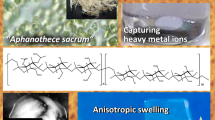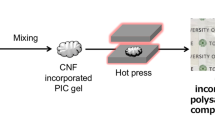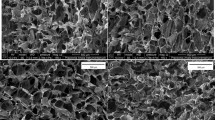Abstract
Anionic polysaccharides (“sacran”) are expected to be useful as medical materials, such as cell cultivation scaffolds. In this study, polymer complex gels of sacran with cell-compatible proteins and collagen were prepared. Complex gels of sacran and collagen were observed using fluorescence and polarized microscopes, which indicated the complexation characteristics of sacran and collagen, as well as their partial orientation. Infrared spectroscopy revealed the gel formation of the polymer complexes. The addition of NaCl was observed to control the uniformity of the complex gels, which suggests that the main interaction in the complexation of anionic sacran with cationic functional groups of collagens is ionic. The swelling degree of the complex gel was significantly lower than that of the sacran-only gel, and the degree of cell adhesion of the complex gel was as high as that on tissue culture-treated polystyrene (positive control); this indicates that the introduction of collagen into sacran gels is effective for cell cultivation.
This is a preview of subscription content, access via your institution
Access options
Subscribe to this journal
Receive 12 print issues and online access
$259.00 per year
only $21.58 per issue
Buy this article
- Purchase on Springer Link
- Instant access to full article PDF
Prices may be subject to local taxes which are calculated during checkout








Similar content being viewed by others
References
Theocharis AD, Skandalis SS, Gialeli C, Karamanos NK. Extracellular matrix structure. Adv Drug Deliv Rev. 2016;97:4–27.
Bosman FT, Stamenkovic I. Functional structure and composition of the extracellular matrix. J Pathol. 2003;200:423–8.
Dubiel EA, Martin Y, Vermette P. Bridging the gap between physicochemistry and interpretation prevalent in cell–surface interactions. Chem Rev. 2011;111:2900–36.
Delair T. In situ forming polysaccharide-based 3D-hydrogels for cell delivery in regenerative medicine. Carbohydr Polym. 2012;87:1013–9.
Hong Y, Gong Y, Gao C, Shen J. Collagen-coated polylactide microcarriers/chitosan hydrogel composite: Injectable scaffold for cartilage regeneration. J Biomed Mater Res A. 2008;85A:628–37.
Lau TT, Wang C, Png SW, Su K, Wang D-A. Genipin-crosslinked microcarriers mediating hepatocellular aggregates formation and functionalities. J Biomed Mater Res A. 2011;96A:204–11.
Picheth GF, Pirich CL, Sierakowski MR, Woehl MA, Sakakibara CN, de Souza CF, et al. Bacterial cellulose in biomedical applications: a review. Int J Biol Macromolecules. 2017;104:97–106.
Okeyoshi K, Okajima MK, Kaneko T. The cyanobacterial polysaccharide sacran: characteristics, structures, and preparation of LC gels. Polym J. 2021;53:81–91.
Ngatu NR, Okajima MK, Yokogawa M, Hirota R, Eitoku M, Muzembo BA, et al. Anti-inflammatory effects of sacran, a novel polysaccharide from Aphanothece sacrum, on 2,4,6-trinitrochlorobenzene–induced allergic dermatitis in vivo. Ann Allergy Asthma Immunol. 2012;108:117–22.e2.
Puluhulawa LE, Joni IM, Mohammed AFA, Arima H, Wathoni N. The use of megamolecular polysaccharide sacran in food and biomedical applications. Molecules. 2021;26:3362.
Okajima MK, Higashi T, Asakawa R, Mitsumata T, Kaneko D, Kaneko T, et al. Gelation behavior by the lanthanoid adsorption of the cyanobacterial extracellular polysaccharide. Biomacromolecules. 2010;11:3172–7.
Okajima MK, Nakamura M, Mitsumata T, Kaneko T. Cyanobacterial polysaccharide gels with efficient rare-earth-metal sorption. Biomacromolecules. 2010;11:1773–8.
Shikinaka K, Okeyoshi K, Masunaga H, Okajima MK, Kaneko T. Solution structure of cyanobacterial polysaccharide, sacran. Polymer. 2016;99:767–70.
Goto M, Azuma K, Arima H, Kaneko S, Higashi T, Motoyama K, et al. Sacran, a sulfated polysaccharide, suppresses the absorption of lipids and modulates the intestinal flora in non-alcoholic steatohepatitis model rats. Life Sci. 2021;268:118991.
Motoyama K, Tanida Y, Hata K, Hayashi T, Higashi T, Ishitsuka Y, et al. Potential use of a megamolecular polysaccharide sacran as a hydrogel-based sustained release system. Chem Pharm Bull. 2014;62:636–41.
Joshi G, Okeyoshi K, Okajima MK, Kaneko T. Directional control of diffusion and swelling in megamolecular polysaccharide hydrogels. Soft Matter. 2016;12:5515–8.
Okeyoshi K, Okajima MK, Kaneko T. Milliscale self-integration of megamolecule biopolymers on a drying gas–aqueous liquid crystalline interface. Biomacromolecules. 2016;17:2096–103.
Okeyoshi K, Joshi G, Rawat S, Sornkamnerd S, Amornwachirabodee K, Okajima MK, et al. Drying-induced self-similar assembly of megamolecular polysaccharides through nano and submicron layering. Langmuir. 2017;33:4954–9.
Okajima MK, Mishima R, Amornwachirabodee K, Mitsumata T, Okeyoshi K, Kaneko T. Anisotropic swelling in hydrogels formed by cooperatively aligned megamolecules. RSC Adv. 2015;5:86723–9.
Bunyaratavej P, Wang H-L. Collagen membranes: a review. J Periodontol. 2001;72:215–29.
Visser R, Arrabal PM, Santos-Ruiz L, Fernandez-Barranco R, Becerra J, Cifuentes M. A collagen-targeted biomimetic RGD peptide to promote osteogenesis. Tissue Eng A. 2013;20:34–44.
Burgess BT, Myles JL, Dickinson RB. Quantitative analysis of adhesion-mediated cell migration in three-dimensional gels of RGD-grafted collagen. Ann Biomed Eng. 2000;28:110–8.
Yamada S, Yamamoto K, Ikeda T, Yanagiguchi K, Hayashi Y. Potency of fish collagen as a scaffold for regenerative medicine. BioMed Res Int. 2014;2014:302932.
Smith JW. Molecular pattern in native collagen. Nature. 1968;219:157–8.
Nomura S, Hiltner A, Lando JB, Baer E. Interaction of water with native collagen. Biopolymers. 1977;16:231–46.
Park J-C, Hwang Y-S, Lee J-E, Park KD, Matsumura K, Hyon S-H, et al. Type I atelocollagen grafting onto ozone-treated polyurethane films: Cell attachment, proliferation, and collagen synthesis. J Biomed Mater Res. 2000;52:669–77.
DeLustro F, Condell RA, Nguyen MA, McPherson JM. A comparative study of the biologic and immunologic response to medical devices derived from dermal collagen. J Biomed Mater Res. 1986;20:109–20.
Wood GC. The formation of fibrils from collagen solutions. 2. A mechanism of collagen-fibril formation. Biochem J. 1960;75:598–605.
Rosenblatt J, Devereux B, Wallace DG. Injectable collagen as a pH-sensitive hydrogel. Biomaterials. 1994;15:985–95.
Silver FH, Freeman JW, Seehra GP. Collagen self-assembly and the development of tendon mechanical properties. J Biomech. 2003;36:1529–53.
Achilli M, Mantovani D. Tailoring mechanical properties of collagen-based scaffolds for vascular tissue engineering: the effects of pH, temperature and ionic strength on gelation. Polymers. 2010;2:664–80.
Yang Y-l, Kaufman LJ. Rheology and confocal reflectance microscopy as probes of mechanical properties and structure during collagen and collagen/hyaluronan self-assembly. Biophysical J. 2009;96:1566–85.
Yu X, Yuan Q, Yang M, Liu R, Zhu S, Li J, et al. Development of biocompatible and antibacterial collagen hydrogels via dialdehyde polysaccharide modification and tetracycline hydrochloride loading. Macromol Mater Eng. 2019;304:1800755.
Norris K, Mishukova OI, Zykwinska A, Colliec-Jouault S, Sinquin C, Koptioug A, et al. Marine polysaccharide-collagen coatings on Ti6Al4V alloy formed by self-assembly. Micromachines. 2019;10:68.
Xu J, Zheng S, Hu X, Li L, Li W, Parungao R, et al. Advances in the research of bioinks based on natural collagen, polysaccharide and their derivatives for skin 3D bioprinting. Polymers. 2020;12:1237.
Okajima MK, Bamba T, Kaneso Y, Hirata K, Fukusaki E, Kajiyama SI, et al. Supergiant ampholytic sugar chains with imbalanced charge ratio form saline ultra-absorbent hydrogels. Macromolecules. 2008;41:4061–4.
Omidian H, Hashemi SA, Sammes PG, Meldrum I. A model for the swelling of superabsorbent polymers. Polymer. 1998;39:6697–704.
Raju MP, Raju KM. Design and synthesis of superabsorbent polymers. J Appl Polym Sci. 2001;80:2635–9.
Ross AM, Jiang Z, Bastmeyer M, Lahann J. Physical aspects of cell culture substrates: topography, roughness, and elasticity. Small. 2012;8:336–55.
Okajima-Kaneko M, Ono M, Kabata K, Kaneko T. Extraction of novel sulfated polysaccharides from Aphanothece sacrum (Sur.) Okada, and its spectroscopic characterization. Pure Appl Chem. 2007;79:2039–46.
Amornwachirabodee K, Okajima MK, Kaneko T. Uniaxial swelling in LC hydrogels formed by two-step cross-linking. Macromolecules. 2015;48:8615–21.
Tsutsumi S, Shimazu A, Miyazaki K, Pan H, Koike C, Yoshida E, et al. Retention of multilineage differentiation potential of mesenchymal cells during proliferation in response to FGF. Biochem Biophys Res Commun. 2001;288:413–9.
Acknowledgements
This work was financially supported by the Shibuya Science and Sports Culture Foundation and partially supported by a Japan Society for the Promotion of Science (JSPS) Grant-in-Aid for Early-Career Scientists (21K14681) and the A-step (AS2915173U) of the Japan Science and Technology Agency (JST), Japan.
Author information
Authors and Affiliations
Corresponding author
Ethics declarations
Conflict of interest
The authors declare no competing interests.
Additional information
Publisher’s note Springer Nature remains neutral with regard to jurisdictional claims in published maps and institutional affiliations.
Rights and permissions
About this article
Cite this article
Takada, K., Komuro, A., Ali, M.A. et al. Cell-adhesive gels made of sacran/collagen complexes. Polym J 54, 581–589 (2022). https://doi.org/10.1038/s41428-021-00593-w
Received:
Revised:
Accepted:
Published:
Issue Date:
DOI: https://doi.org/10.1038/s41428-021-00593-w



